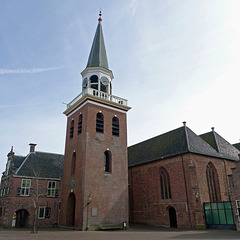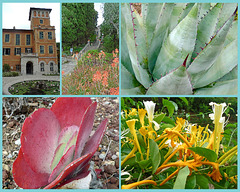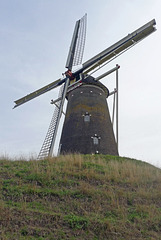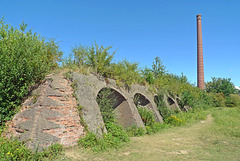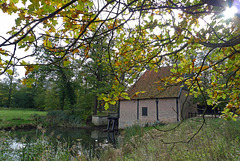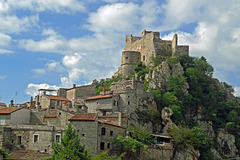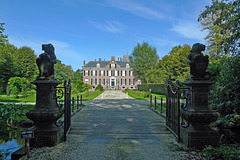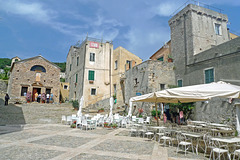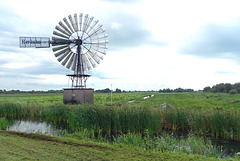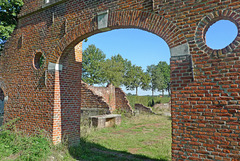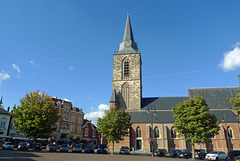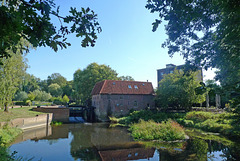Jaap van 't Veen's photos
Nederland - Appingedam, Nicolaïkerk
| |
|
|
|
The Nicolaïkerk (Nicolai Church) is a hall church with three naves, built in a Romano-Gothic style. This church is the biggest in the province of Groningen, apart from the Martini-church and the A-church which are situated in the city of Groningen.
The building of the church was completed in seven phases between approximately 1200 and 1560. Its construction closely followed the development of Appingedam, the most important harbour in the province of Groningen during the Middle Ages. In the first instance a hall-church was built between 1200 and 1225, consisting of the two first bays of the nave with dome-shaped vaults and a tower.
After several enlargements and addtions, the church became its current shape. The outside measurements are approximately: length = 48 meters, width = 28 meters and from the top of the vault to the floor 13 meters in height.
The first tower of the church was built on the west-side. Mid 16th century that tower was demolished because it was thought that it caused too much pressure on the building. A new built tower was demolished in 1835 due to its condition. The present tower clashes somewhat with the church building.
Originally the church was dedicated to Maria, but changed early in the 15th century to St. Nicholas, patron saint of the sailors and merchants. The Nicolaïkerk is s Dutch national heritage site since 1968 and one of the top 100 sites in the Netherlands.
Italy - Ventimiglia, Hanbury Botanical Gardens
| |
|
|
|
The Hanbury Botanical Gardens (Giardini Botanici Hanbury) have their origin in 1867, when Thomas Hanbury bought the ancient Palazzo Orengo and the adjacent pieces of land, in order to transform them into a garden of exotic plants. Half of the gardens are cultivated with (sub)tropical plants; the other half is occupied by a Mediterranean self-vegetation. In the garden one can discover for instance agaves, aloes, succulent plants, cactuses and citrus and exotic fruits trees.
After some years the garden was well-known because of its richness in plants and the importance of its collection. The Hanbury Botanical Gardens extends on a surface of 18 hectares, nearby the frontier between Italy and France. In 1960 the garden - which was seriously damaged during World War II - was sold to the Italian state. In 1987 the management of the garden was entrusted to the University of Genua. In 2001 the Hanbury Botanical Gardens became also a nature reserve.
We had read many positive reviews about the gardens, but honestly, we were quite disappointed. It made a rather 'withered' impression on us.
Nederland - Bredevoort, De Prins van Oranje
| |
|
|
|
Bredevoort - once a walled city - received permission from Stadholder Frederik Hendrik to build a post mill in 1644. This mill - De Prins van Oranje - was built on one of the city's bastions. After the mill burned down in 1869, the current brick beltmolen (belt = a man-made mound) was built a year later.
De Prins van Oranje remained in operation for almost the entire 20th century, with necessary modernisation taking place. The mill was restored in 1968 and continued to operate thereafter. In 1990, this seemed to have ended due to damage, but repairs followed two years later. The mill is still milling and is often milled by voluntary millers.
De Prins van Oranje is listed as a Dutch national monument.
Nederland - Delden, Kasteel Twickel, tuin en park
| |
|
|
|
Kasteel Twickel (twickel Castle) is well-known for its gardens and park. The gardens have been developed by the various generations and give a good impression of the history since the Renaissance.
The formal garden offers clipped figures of the taxus and buxus trees. The ornamental garden garden in Victorian style has been designed by the last baroness. The surrounding park - with its large water gardens - are developed in English landscape style during the 18th and 19th century. The park has also a wildlife sanctuary with a pack of fallow deer.
The orangery was built in the first half of the 19th century. It serves as a winter residence for the (sub)tropical plants, such as the 300 year old orange trees.
Nederland - Delden, Kasteel Twickel
| |
|
|
|
Twickel is a unique historical country estate in Twente (eastern part of the Netherlands) and is no less than 4.100 ha. The setate was established during the Middle Ages. Between 1347 and 1953 Twickel was continually passed on from father to son or daughter. The last owner , baroness Van Heeckeren van Wasssenaer, countess Van Aldenburg Bentinck, who had no children, decided in 1953 to establish a foundation in order to preserve the estate as a nature reserve and cultural mionument. Nowadays Twickel is one of the largfest and best preserved private estates in the Netherlands.
Kasteel Twickel (Twickel Castle) is situated in the centre of the estate. The older parts, among which the tower at the front, date from the 15th century. Throughout ther centuries ther castle has been extended and beautified. The buildings, stables and coach house in the forecourt were added during the 18th century.
Kasteel Twickel is still inhabited and therefore the castle is open for visitors to a limited extent.
Italy - San Remo, Chiesa di Cristo Salvatore
| |
|
|
|
Chiesa di Cristo Salvatore (Church of Christ the Saviour) is an Russian orthodox church, dating back to the year 1915. It was built for the Russian community that followed Tsarina Maria Aleksandrovna (wife of Tsar Alexander II) to San Remo in 1906; the foundation stone was laid in 1912. In that period about one thousand Russians lived in the town.
The Chiesa di Cristo Salvatore - with its onion domes and heavenly pale-blue interior - was designed by Alexei Shchusev, later finished by local engineer Pietro Agosti. Icons and murals of Christian saints line the interior. The appearance of the temple imitates the style of typical 17th-century Moscow churches. It has five domes, three altars and a belfry.
The church is still used today by the Orthodox community of San Remo and is one of the landmarks of San Remo.
Nederland - Fortmond, steenfabriek
| |
|
|
|
Steenfabriek Fortmond is a former brick factory in the Duursche Waarden floodplain of the river IJssel near Fortmond; a hamlet which was created by the construction of houses for the workers.
Bricks were baked at this location on the banks of the river IJssel long before the factory was built. In so-called field kilns, tiggels (bricks) were baked from river clay. A first factory was built in 1828 and Steenfabriek Fortmond (Fortmond brick factory) was founded in 1889. The existing ring kilns and chimney were built in 1919 and 1920. In 1976 the factory was closed during a remediation round aimed at reducing overcapacity in the business sector.
In 1986 Staatsbosbeheer (a Dutch government organisation for forestry and the management of nature reserves) became manager of the site with the buildings and the surrounding floodplains. The values have been developed from 1989 into the Duursche Waarden nature reserve.
After the complex was designated a Dutch national monument in 2003, the forty-meter high chimney, which has become rare of its kind, underwent a thorough renovation that was completed in 2006. This chimney still is a well-recognized landmark from afar. The ruins of the two dozen meters long and approximately five meters high brick ring kilns (dating back to 1919/1920), overgrown with trees and shrubs, remain in the natural state of decay in which they have been for decades.
Nederland - Delden, De Noordmolen
| |
|
|
|
De Noordmolen is a watermill which is more than 650 years old. In May 1347, Herman van Twicklo bought Huize Eijsink and the Noordmolens (mills) situated along the Azelo stream from the nobleman Berend van Hulscher. The deed of sale has been preserved in the archives of Kasteel Twickel (Twickel Castle) in which mention is made of the Noordmolens. In the past, there was a corn mill opposite the present oil mill (see PiP4); this was demolished in 1831.
De Noordmolen has been restored several times. In 1917, the mill was repaired, but stood still, partly due to lack of water, leading to renewed decay. In the years 1976-1978, the mill building was once again restored by order of the Twickel foundation. In 1984, the mill received a new water wheel. A last major renovation took place in 2006.
De Noordmolen has always belonged to the Twickel estate. Since 1990, volunteers have kept the watermill in operation and visitors are able to see how oil is extracted from linseed.
Italy - Castelvecchio di Rocca Barbena
| |
|
|
|
Castelvecchio di Rocca Barbena is a quiet village located in the green hills north-west of Albenga in the western part of Liguria. The small village has a very well preserved medieval centre with a maze of narrow alleys and steep dark stairs. Stone houses and their ancient architectural features give the village an unspoiled character.
Castello dei Clavesana - dating back to the 9th and 10th century - is a castle overlooking the village from the hill behind. The castle was damaged during a siege by an army from Genoa in 1672, since that time it has been in its current ruined condition. Castelvecchio di Rocca Barbena developed from the 11th century onwards around the outside of the castle walls.
The Church of Our Lady of the Assumption is a very simple small church that was originally built in the 15th century, and then substantially altered in the 17th century to incoporate baroque style elements.
Castelvecchio di Rocca Barbena is one of the borghi pui bella d'Italia (one of the most beautiful villages in Italy.
We visited Castelvecchhio di Rocca Barbena on a Sunday morning. During our vist we didn’t see a single inhabitant and that made the village look like a ghost town.
Nederland - Olst, Groot Hoenlo
| |
|
|
|
Landgoed Hoenlo (Hoenlo Estate) covers 145 hectares with the functions agriculture, forestry and nature. The main building of the estate is the manor Groot Hoenlo .
The name Hoenlo was first mentioned in 1230. In 1368, a havezate (manorial farm) was built at this location. The present manor house was probably originally built in the 18th century as an extension of an older building.
In 1802 the Groot Hoenlo came into the possession of the Teding van Berkhout family. In the period 1895-1907, a series of renovations were carried out and the original house was almost completely replaced and received its present appearance and interior.
Until 1950, Hoenlo was still one of the largest estates in the province of Overijssel with five country houses, more than 750 hectares of land and 25 tenant farms. After that it disintegrated. In 1985, Groot Hoenlo was divided into several appartments.
Groot Hoenlo became well-known because Harry Mulisch - one of the greatest Dutch writers - lived in the house for some time.
Nederland - Noordwolde, Windlust
| |
|
|
|
Windlust is a octagonal smock mill, which was built in 1860 and raised in 1880. Fourty years later a brick engine-house was added to the base of the mill. In the 1930s the mill worked mostly by engine, but by wind during World War !!. After the war the condition of the mill deteriorated and it ceased working in 1953. Around 1960 it was restored and some years later left to the foundation De Oosthoek .
Windlust is a so called stellingmolen ; the stage is 6.20 meters above the ground. The mill has a brick base and the smock and cap are thatched.
Nowadays Windlust - a flour mill - is still in working order and is kept running by volunteers. The mill - listed as a Dutch national monument - can be visited on most Saturdays.
Italy - Borgio Verezzi
| |
|
|
|
Borgio Verezzi is a little village on the Riviera di Ponente, which has two distinct areas: a beach resort along the coast of the Mediterranean Sea called Borgio and the medieval village of Verezzi in the hinterland on a hill. There are actually four separate hamlets that make up Verezzi: Crosa, Piazza, Poggio, and Roccaro.
The centre of the medieval village of Verezzi is Piazzetta Sant'Agostino, surrounded by ancient buildings and the 14th century Church of Sant'Agostino.
Borgio Verezzi is listed as one of the most beautiful villages in Italy ( il borghi pui bella d'Italia ).
During our visit, a wedding ceremony took place in the small church, so we could not take a look inside.
Nederland - windmotor De Veenhoop
| |
|
|
|
Windmotor De Veenhoop is a polder windmill near the Frisian village of De Veenhoop. It is a so called American windmill (in the Netherlands also called roosmolen ). This type of windmills was developed in the United States and was used for irrigation purposes. In the Netherlands, these mills are used as polder mills. De Veenhoop is of the brand Herkules and was built in the German city of Dresden.
From 1921 to 1962, the mill was used for draining a nearby polder. The mill was sold, but in 1996 it was in very poor condition. Five years later, the mill was refurbished and used again at its present location to drain the Groote Veenpolder .
Nederland - Elspeet, De Hoop
| |
|
|
|
Already in the year 1565 there was a windmill in Elspeet. Perhaps it was this mill that burned to the ground in 1893. The present windmill De Hoop - the successor of the burnt down mill - originates from Wateringen, where it was built in 1847 as a poldermill. The year it was rebuilt in Elspeet is probably 1894.
De Hoop was restored in 1962 and 1972, but after the last restoration it was no longer in use. For years the mill was very desolate. In November 2010 this came to an end with the start of a thorough restoration. Both the exterior and the interior were restored. In the spring of 2013 the mill could be used as a corn mill again.
De Hoop is a special mill, because it is a combination of a belt (= man made mound) and a stelling (= stage tower) mill. Originally, a platform was attached to the 3.60-metre-high mound. During the last restoration, the platform was removed. There is a mill shop in the mound, which sells various types of flour.
Italy - Finalborgo
| |
|
|
|
Finalborgo is a small walled town not far from the Mediterranean Sea. The name derives from “Burgum Finarii”, border land (for fines) to the times of the Romans and administrative center of the marquisate of the Del Carretto family between the 14th and the 16th century. The origin of the village dates back to the end of the 12th century, to the epoch of the marquis Enrico The Guercio. Recent important archaeological discoveries, however, date back its foundation to some centuries before.
With the walls, the different city-gates and the semicircular towers which interrupted to treat the walls Finalborgo retains the characteristics of a fortified village in its 15th-century structure, rear to the destruction resulting from the war with Genoa (1448). The 15th-century and Renaissance palaces, altered during the period of Spanish domination, embellish the urban fabric.
Nowadays Finalborgo is considered being one of the most beautiful villages in Italy due to its history, places to visit and natural beauty. The town belongs to il borghi pui bella d'Italia (the most beautiful villages in Italy).
Nederland - Winterswijk, Het Hemmink
| |
|
|
|
The farmhouse Het Hemmink is mentioned as early as 1331.
In the mid-19th century, the Esselink family lived at Het Hemmink , a larger farmhouse that took its current form in 1903. Due to an inheritance issue, the farm fell into disrepair. In the 1950s, the owner along with his wife died in a car accident.
The heirs could not agree on inheritance rights for a long time. In the end, Het Hemmink went to a relative in Hilversum, who did not care for his possession. In the 1980s, the farm was occupied by squatters and decayed completely. During 1995-96, most of the ruin was dismantled, leaving only a few remnants of walls standing today.
Nederland - Winterswijk, Jacobskerk
| |
|
|
|
The Jacobskerk (St James' Church) is medieval village church of Winterswijk and is located in the center of the village on the Markt. The Gothic-style building has the status of a national monument. The church is dedicated to St James the Greater, the patron saint of pilgrims to Santiago de Compostella.
The history of the church dates back to around the year 785 when a small wooden church was built. Around 1225, the first stone church building was built here: a three-aisled nave and a single-aisled choir, remnants of which were found during the last restoration. Mid 15th century a large-scale renovation was started that would last no less than a century. At that time, the sacristy (now the garrison room) was created and the Romanesque nave and tower were retained.
In 1507, the Romanesque tower was demolished and replaced by a tower in late Gothic style. Around 1550, rebuilding came to an end and the church, then called Jacobskerk , had its current shape. Nothing remains of the Romanesque part, although its stones were used to build the Gothic nave of today's church.
During the Reformation, the name of the church changed into Jacobskerk .
Nowadays the Jacobskerk is still used for worship services and is also designated as official wedding location of the municipality of Winterswijk.
Nederland - Winterswijk, Berenschot’s Watermolen
| |
|
|
|
Berenschot's Watermolen is located on the river Boven-Slinge and was built in 1749. An mention from 1652 refers to the predecessor of the current mill. Originally, the complex consisted of two mills: a corn mill (now Berenschot's Watermolen ) and an oil mill on the other side of the stream.
Between 1652 and 1718, the two mills were owned by the Van Eerde family, owners of the Hazezate Plekenpol (a manor or fortified farmhouse). A new owner had the present mill building built in 1749. Probably the old mill had fallen into too much disrepair. In 1848, the oil mill collapsed and was never rebuilt.
In 1911, G.W. Berenschot bought the corn mill, to which it owes its name. In 1960, the mill fell out of use after a major flood and lasted until the 1980s. All those years, there was talk of a restoration, but no action was taken. By the end of 1984, the time had come and the mill was given a major overhaul. Between 1988 and 1991, part of the mill building was restored and converted into a restaurant.
The mill/restaurant (a Dutch national monument) is still owned by the Berenschot family.
Jump to top
- ipernity © 2007-2024
- Help & Contact
|
Club news
|
About ipernity
|
History |
ipernity Club & Prices |
Guide of good conduct
Donate | Group guidelines | Privacy policy | Terms of use | Statutes | In memoria -
Facebook
Twitter

